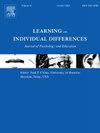Motivational profiles among high-ability students from a self-determination perspective: Stability, antecedents, and comparisons with average-ability students
IF 3.8
1区 心理学
Q1 PSYCHOLOGY, EDUCATIONAL
引用次数: 0
Abstract
According to self-determination theory, motivation varies based on the fulfillment of psychological needs, ranging from autonomous to controlled forms. Cognitively high-ability students (IQ ≥120) may face unmet needs in general education, which is designed primarily for average learners. This study, involving two large samples (Sample 1: N = 3429 students; Sample 2: N = 5740 students) explores motivational profiles among high-ability students across four education stages, comparing them with average-ability students. Using latent profile and transition analysis, it identifies consistent profiles and transitions. High-ability students, more prevalent in profiles characterized by lower autonomous motivation, shifted towards even lower levels during secondary school. Insufficient curricular challenge, reported to a greater extent by the high-ability students, was linked to the lower quality profiles. Findings emphasize the necessity for tailored secondary school environments to better address the unique needs of high-ability students, highlighting the importance of adequate challenge for fostering quality motivation.
Educational relevance and implications
This study found less optimal motivation among high-ability students when compared to their peers. This was especially apparent in secondary school. Sufficient challenge in the curriculum was linked to higher quality motivation, and the high-ability students reported lower levels of adequate curricular challenge. These findings suggest that school environments must do more to meet the educational needs of high-ability students to foster their motivation for school, particularly by offering adequate challenge.
求助全文
约1分钟内获得全文
求助全文
来源期刊

Learning and Individual Differences
PSYCHOLOGY, EDUCATIONAL-
CiteScore
6.60
自引率
2.80%
发文量
86
期刊介绍:
Learning and Individual Differences is a research journal devoted to publishing articles of individual differences as they relate to learning within an educational context. The Journal focuses on original empirical studies of high theoretical and methodological rigor that that make a substantial scientific contribution. Learning and Individual Differences publishes original research. Manuscripts should be no longer than 7500 words of primary text (not including tables, figures, references).
 求助内容:
求助内容: 应助结果提醒方式:
应助结果提醒方式:


